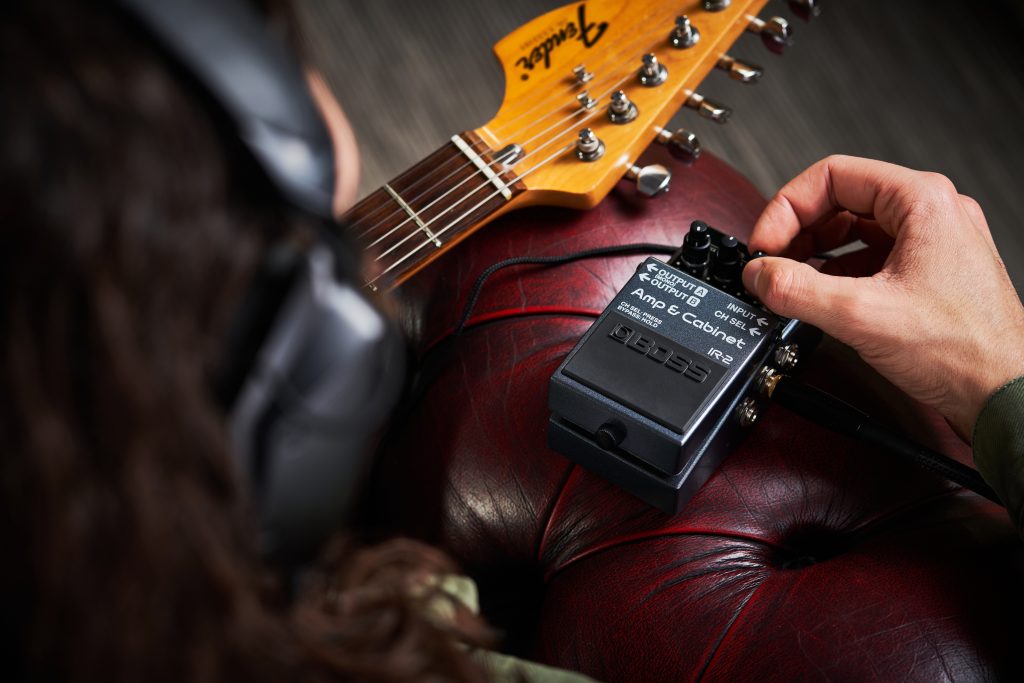While digital modeling isn’t a new invention, the accuracy, versatility, and quality of impulse responses and modern cabinet simulators have had a remarkable impact. They expand tonal creativity, streamline setups, and provide access to previously unobtainable gear. Plus, impulse responses ensure that you can replicate your exact guitar tone whether you’re at home, in a studio, or on stage. In short, they are total game-changers for guitarists and bass players everywhere.
In this guide to IR pedals and cab simulators, we’ll cover:
- What is an impulse response (IR) pedal?
- The difference between impulse response and cab simulators
- The benefits of using an impulse response pedal for guitar
- How to use an impulse response pedal
What is an Impulse Response (IR) Pedal?
An impulse response, in terms of its application to guitar, is a sonic snapshot measuring the exact sound of a complete amplifier setup. That includes the speaker cabinet, microphone, microphone placement, room, and peripheral equipment. This snapshot replicates conditions in any situation—from practicing with headphones to running the IR to the front of house.
It’s important to note that IRs are digital captures of real-world equipment. They aren’t interpretations or approximations, like many amp-in-a-box type effects pedals. They are audio files capturing the tonal qualities and character of a setup within the entire 20Hz to 20kHz frequency range. An IR loader interprets the audio file to replicate those sonic characteristics.
Impulse response pedals like the BOSS IR-2 or IR-200 combine an impulse response with cabinet simulation. The result is a self-contained direct sound solution for performance, recording, and woodshedding. These pedals provide enormous amp tones in a small package. After creating tones, sending them to a stage amp, PA, or DAW is easy.
Difference Between IR and Cabinet Simulators
While an IR and a cabinet simulator might at first appear to act in similar roles in a guitarist’s setup, they are, in fact, very different. Firstly, a cabinet simulator is an approximation of what a particular cabinet sounds like. That simulation will consider speakers, cabinet size, microphone, and mic placement. Still, it is simply an interpretation of those features.
An IR has been physically recorded and measured, then recreated via an IR loader. It is a scientifically accurate, virtual snapshot of real-world physical equipment. So, where a cabinet simulator might interpret the sound of an Orange closed-back 4×12, an IR would faithfully recreate the sound of the particular Orange closed-back 4×12 used for reference.

Additionally, an IR isn’t limited to just recreating the sound of a cabinet. It can interpret the complete recording setup for the equipment. An IR can consider the cabinet, microphone, mic placement, rack gear, effects pedals, and room. They offer a solution for accurately recreating some of the world’s best and most sought-after guitar equipment.
It’s also worth noting that IRs exist and have applications beyond just guitar equipment. IRs can capture many things, such as the natural reverb of a particular room. For example, Abbey Road Studios in London offers impulse response captures of their reverb chambers. You can virtually re-amp your guitars, vocals, or percussion through these IRs and simulate the echo of the world’s most famous studio.
"The flexibility and high quality of an IR can remove the need for last-minute tonal tweaking."
Impulse Response Benefits
The benefits of using IRs in a guitar setup are substantial. There are so many variables involved in creating a great guitar tone. They range from the volume of an amplifier to the microphone. It isn’t easy to consistently recreate sounds between venues, rehearsal rooms, and home practice. But an IR allows you to craft your tone at home carefully and replicate it no matter where you’re playing.
Access Premium Amplifiers and Studio Equipment
IRs also give you access to a massive catalog of premium gear and tones—from boutique amplifiers to a classic Royer R-121 ribbon microphone. IRs capture some of the world’s most prestigious recording studio spaces. The quality and accuracy of their replication give every musician the chance to perfectly simulate some of the most incredible guitar tones in history.
Additionally, the hard work of setting up and perfectly recording a fantastic guitar rig is complete. There is no need for expertise in mic placement or an engineer. You are free to focus on being creative and sounding great.

Create a Completely Ampless Guitar Rig
Using IRs in a guitar rig also lets the player be completely ampless. IRs represent the complete setup, amp, cab, and microphone, and you can send them straight to the front of house. Setup and changeovers get streamlined, and transportation becomes much more manageable. Players can integrate a simple IR pedal into a pedalboard or pack it quickly into a gigbag.
"IRs allow players to perfectly replicate their sound without relying on rentals or borrowed equipment."
Achieve Tonal Consistency
The flexibility and high quality of an IR can remove the need for last-minute tonal tweaking. It ensures that no matter the situation or the conditions around you, your tone will always be as you’ve designed it. Additionally, IRs in the BOSS IR, GT, GX, and Tube Amp Expander products are high-quality and emulate the most sought-after and desirable amplifiers, microphones, and equipment available.

Travel with Ease
IRs are also ideal for fly gigs. They allow touring players to replicate their sound perfectly without relying on rentals or borrowed equipment. For traveling musicians, it’s easy to select different amplifiers, cabinets, microphones, and mic placement options from song to song or verse to chorus. You can blend and switch between professional-quality rigs with ease. This means every sound will have the right tonal qualities, no matter where you’re playing.
Versatile Routing Without all the Cabling
IR pedals allow you to integrate your pedalboard with your rig seamlessly. Pedals like the IR-200 come equipped with a stereo output. This allows players to try different combinations of amplifiers without having to purchase and set up a second amplifier to determine if it blends with your first. Just rotate through a catalog of amplifier combinations to easily find the right pairing for your tone.
HOW AND WHY TO USE AN IMPULSE RESPONSE PEDAL
Live
That tone can go to the front of house at a performance without concern about cabinet micing or bleed from drums and other instruments. In addition, for vintage amplifier owners who worry about taking them out on the road, IRs offer a simple solution. They allow those players to keep their amps in a safe environment while still getting that classic tone night after night.
Even when playing live in some smaller venues, it’s not uncommon for sound people to ask guitarists to turn down their volume. With an IR, it’s possible to crank the modeled amplifier and then attenuate the volume for the space around you.
"IR pedals, like the BOSS IR-200, can go straight to an interface. This captures pro tones straight into a DAW without the need for space, soundproofing, and volume."
Studio
IRs are a high-quality, consistent, and easy-to-use tool that can improve the tone of any studio setup and expand creative options. It’s also quick and easy to record incredible guitar tones at home. IR pedals, like the BOSS IR-200, can go straight to an interface. This captures pro tones straight into a DAW without the need for space, soundproofing, and volume.
Try integrating your favorite IRs into your recordings. Having instant recall of your favorite saved live tones can make sessions move quickly. You can even map guitar tones as IRs before tracking to maximize recording time. Also, impulse response software is readily available, and there are many online resources where musicians collect IRs.
Practice
IRs can transform how a guitar player practices at home using headphones. There’s no need to play quietly through an amplifier or to use a smaller practice amp that doesn’t accurately recreate your tone. With IRs, the tone you create and use is the same in every situation.
Choosing an Impulse Response Pedal
Do Impulse Response Pedals Vary in Quality?
When choosing a pedal, both the hardware and software make a difference. While there are numerous impulse response pedals on the market, cheap models cut corners on build quality. Integrating IRs can supercharge a guitar rig, so investing in a long-lasting pedal with cutting-edge technology will reap great rewards. In addition to their legendary roadworthiness, BOSS IR pedals offer class-leading IR reproducibility and up to 500 ms of IR time.

"In addition to their legendary roadworthiness, BOSS IR pedals boast exceptional audio quality and up to 500 ms of IR time."
BOSS Impulse Response Pedals
They’re available in many different formats from BOSS, suitable for all different types of players and budgets. The IR-2 and IR-200 give players with stompbox-based pedalboards the ability to integrate IRs without sacrificing their pedals.
Other BOSS Pedals with IR Functionality
The GX-100 and GT series provide a one-stop solution for effects and amplifier management. The Tube Amp Expander allows valve amp enthusiasts to make the most of their amplifier’s coveted tone. The ME-90 offers an affordable, easy-to-use range of simple effects and impulse responses in a popular multi-effects format.







